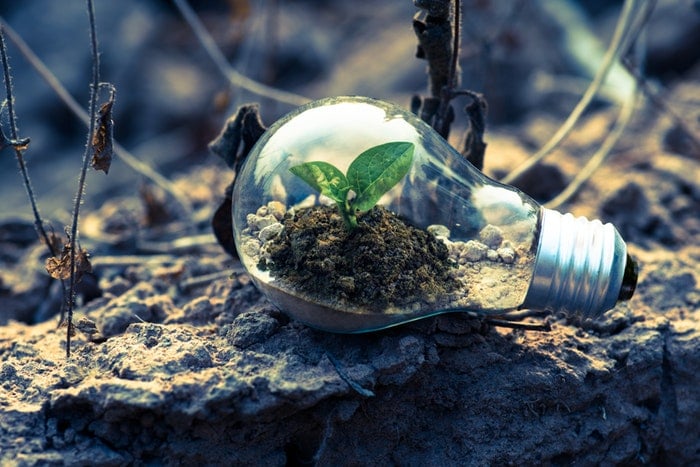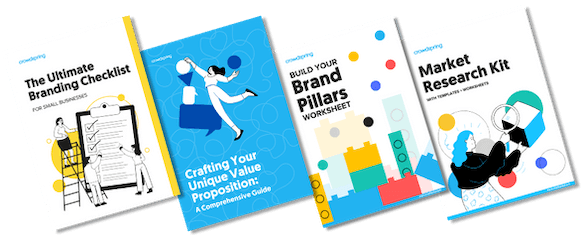Sustainable Design Can Help Your Small Business and Improve the Environment

Smart businesses know that people, especially millennials and Gen Z, are increasingly concerned about the environment.
In fact, a peer-reviewed study in The Lancet revealed that pollution continues to be a major global health concern.
In response to this global trend, businesses adopt environmentally-friendly strategies when they design products, product packaging, and marketing their business.
Environmentally friendly strategies not only help the environment but can also help the bottom line.
A recent study revealed that 92% of consumers have a more positive image of a company when it supports an environmental cause.
If you’re running an existing business that hasn’t yet adopted sustainable design principles, this is the perfect time to pivot. And if you’re just starting a business and looking for ways your go-to-market strategy can differentiate from the competition, consider sustainable design as a differentiator.
Your small business or startup can incorporate sustainable practices to save money and help save the planet. Here’s how…
What is sustainable design?
A sustainable business, or a green business, is a business that strives to create the smallest amount of impact on the environment possible.
Sustainable design is a similar concept. It refers to any design concept that has a minimal negative impact on its environment, community, and economy.
German industrial designer Dieter Rams’ renowned design principles emphasize that good design should be “environmentally friendly”:
Design makes an important contribution to the preservation of the environment. It conserves resources and minimizes physical and visual pollution throughout the lifecycle of the product.
There are three areas where your business can significantly impact sustainability: product packaging, brand identity, and website design.
These areas are responsible for some of the highest outputs of waste and an increased carbon footprint.

Method’s clean packaging echoes the commitment to eco-friendly cleaning solutions.
Make your product packaging eco-friendly
Product packaging has a powerful impact on consumers. As we recently wrote:
There is impressive evidence in support of the power of packaging design:
Attractive packaging triggered more intense activity in areas of the brain associated with impulsivity than neutral packaging.
Unattractive and attractive packaging lead to less activity in areas of the brain responsible for reflective thought than neutral packaging.
Attractive packaging triggered reward responses in the brain whereas unattractive packaging triggered areas associated with negative emotion.
Making your packaging environmentally friendly is an excellent way to make a positive impression on your customers.
For many people, sustainable packaging is also a major influence on purchasing decisions.
According to a recent Nielsen study, 3 out of 4 Millennials and 72 percent of Gen Z polled would pay more for a product with sustainable packaging.
Many strategies are available to update your existing packaging with more environmentally-friendly options.
Essential Branding Toolkit for Entrepreneurs
Build a stronger brand with our free guides. Get actionable insights to define your brand’s unique voice, understand your market, and stand out to customers. The guides are concise, actionable, practical, and tailored for the busy entrepreneur.

- The Ultimate Branding Checklist
- Crafting Your Unique Value Proposition
- Build Your Brand Pillars Worksheet
- Market Research Kit
Choose green materials
Apple is widely regarded as an industry leader in beautiful, forward-thinking design.
However, one of the significant announcements from Apple’s recent product announcements wasn’t a new fancy phone or laptop. Both of the new machines they announced – the MacBook Air and Mac Mini – are made with 100% recycled aluminum. Apple said:
Using this custom aluminum alloy helps reduce MacBook Air’s carbon footprint by nearly 50 percent, making it the greenest Mac ever.
Packages that use green materials like recycled aluminum save energy and reduce landfill waste. This is compelling for environmentally concerned consumers.
Make it biodegradable or recyclable
Using recycled materials is a great start to creating a sustainable product. You can also consider using biodegradable materials.
Here are some commonly-used materials that are biodegradable or recyclable:
- Paper and cardboard. These readily available options have the triple benefit of being reusable, recyclable, and biodegradable.
- Corn starch. Packaging made from corn starch is biodegradable and commonly used to hold food and other limited-use items. Packaging “peanuts” made from corn starch are also available, so if you’re looking for green packing material, it may fit the bill.
- Bubble wrap. Everyone’s favorite stress reliever is generally made from plastic, but that doesn’t mean it’s bad for the environment. If you need to use bubble wrap, use some that are biodegradable.
- Biodegradable plastic. This may sound like an oxymoron, but some plastics can biodegrade. They may not be 100% as eco-friendly as other options like cardboard, but a biodegradable version might do the trick if you need plastic in your packaging.
Repurpose your packaging
Adopting packaging that can be repurposed later is an excellent strategy for increasing your green factor.
We talked about an example of an innovative packaging design when we recently looked at packaging trends:
One Indonesian company has found a way to create packaging that you can eat. Evoware is food packaging made from seaweed that is nutritious if you eat it, and biodegrades if you opt to throw it out.
Puma spent months finding a way to repurpose their shoeboxes. They ended up eliminating the box and creating the “clever little bag” in its place.
Their shoes now come in a bag that can be reused many times after its life as a shoe container is over.
The company says they save 8500 tons of paper, 20 million megajoules of electricity, and 1 million liters of water with this change.
That’s thinking outside the box at its best.
Need some more inspiration?
Pinterest is a great resource for innovative packaging design ideas.
And if you’re interested in a good guide on sustainable product design, we recommend you read Product Design Strategies for a Sustainable Future.
Invest in eco-friendly business cards and brochures
You can also adopt eco-friendly practices in building your brand identity.
Your brand identity explains who you are, what value you bring to your customers, and what sets you apart from everybody else.
Your design choices help create a brand identity for your company. Your business cards, product packaging, brochures, and more help establish how customers and prospects perceive your brand.
Let’s start with business card design. As we wrote previously:
There are few statements as widespread in business as “Here’s my card.” Business cards have been a part of any entrepreneur’s self-promotion toolkit for a long time. How long? The Chinese handed out calling cards in the 15th century to let people know they planned to visit. The French in the 17th century swapped cards as a way of introduction, and this spread to the British and eventually America soon after.
Similarly, brochures are versatile marketing products that can help promote your business, highlight important products and services, and help customers and prospects remember your business.
You can still make a great impression with your brochure design by ensuring that your brochures have a minimal environmental impact.
If you need business cards or brochures for your business, consider environmentally-friendly options. For example:
- Numerous companies offer recycled and eco-friendly business cards and brochures. Some companies, for example, use paper from trees harvested under the Sustainable Forest Initiative. Such paper is processed without environmentally harmful bleach and chlorine agents.
- Some companies use waterless printing that doesn’t use toxic chemicals and doesn’t consume tens of thousands of gallons of water as part of the printing process.
- You can find creative business card solutions that include plantable seed business cards.
- If you have a choice of paper or material options, consider cotton or other eco-friendly materials.
Sustainable website design
One place you might not expect to find energy savings?
Your website.
Serving web pages requires computers to run 24/7, and all of that power usage and computing requires large amounts of energy.
It also creates tremendous heat. Web hosting companies also need extensive (and expensive) cooling systems to keep their computers from overheating.
How can you make your website more eco-friendly? By investing in good website design practices.
Make things easier to find
Making information easy to find not only reduces customer frustration but also reduces your energy output.
Find ways to lower the number of “clicks” needed to get to the desired result and reduce the number of pages a customer needs to load.
Using fewer pages reduces the necessary bandwidth and computing power necessary to run your webpage.
Ensure you have a high-functioning search feature on your website, so customers don’t have to dig for what they’re looking for.
Anything you can do to make your website easier to find reduces a computer’s energy output.
Choose a green web host
Web hosting uses a lot of energy.
According to a Greenpeace study, if the Internet were a country, it would rank sixth for energy usage.
Another study concluded that the Internet accounts for almost 1 billion tonnes of CO2 emissions.
Some web hosting companies are trying to reduce the impact websites have on the planet. Some of these companies purchase carbon offsets to make up for their energy, while others tap into renewable energy sources to power their servers.
Consider hosting your site with a provider that works to be more sustainable and eco-friendly.
Lighten your page content
Did you know that readers start abandoning your website after only seconds of load time?
Between seconds 4 and 5 of your website’s load time, 20% of viewers have already left your site. The number only increases from there.
The size of web pages is becoming an increasingly huge problem for businesses.
Make lighter page design a priority for your business.
Lighter pages have many benefits:
- they require less computing power and energy,
- they load faster,
- they use less bandwidth, and
- because there’s less on them, they’re easier to scan.
Take the time to thoroughly audit your website and try to slim them down.
Remove excessive images and videos, or if you have to have them, run them through optimizers like Kraken.io or ImageOptim to shrink their size.
When it comes to creating a sustainable business, every action matters.
Using green packaging design, sustainable business cards, and brochures and incorporating smarter web design strategies are great ways to improve your carbon footprint and gain a loyal customer following.
The planet (and the billions of us living on the planet) will appreciate your efforts.
Design Done Better
The easiest way to get affordable, high-quality custom logos, print design, web design and naming for your business.
Learn How to Grow Your Business With Beautiful Design

